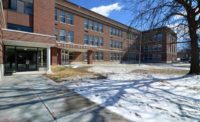Renovation and Adaptive Use of a Historic Structure




Mills + Schnoering Architects, LLC (M+Sa) of Princeton, N.J., completed design of the Rutgers University-Newark Alumni Center renovation and adaptive use project to strengthen alumni and community relations. Opened in Fall 2018, the facility recently completed its first semester of operations. The project builds upon other recent preservation and new construction projects strengthening Newark’s cultural heritage and reinforcing the university’s connection to the city.
“The Alumni Center is an investment in Newark in two fundamental dimensions,” said Rutgers-Newark Chancellor Nancy Cantor. “Physically, it celebrates Newark’s distinguished past while signaling the city’s extraordinary renewal. Metaphorically, it connects generations past and present—alumni and current students—for whom it is a hub for sharing experiences, knowledge, and wisdom.”
The Rutgers University-Newark Alumni Center architectural project combined renovation and adaptive use of the historic 19th century Fewsmith Residence with a compatible, yet contemporary, new addition. The project restored the building’s historic features – a curved marble stair and checkered entrance floor, decorative plaster work, travertine walls, and fireplaces – while providing accessibility upgrades and modern programming.
The Alumni Center design revitalized a building important to Newark’s history and its downtown. The project established a new home for alumni resources and activities, housing both the alumni relations and development offices to promote a deeper connection between alumni engagement and philanthropy. Rental space is available within the building to Newark community members and organizations.
“The re-activation of a prominent site, restoration of an architecturally significant historic structure, and expansion with a contemporary addition combine to reinforce and integrate the fabric of the campus and surrounding community,” said M+Sa Principal Michael J. Mills, FAIA, who led the project. “We’re pleased that the building had a successful first semester rich with events and programming.”
Students, alumni, and user groups participated in discussions to inform the design and programming. An expansion was necessary both to fit the university’s desired program and accommodate necessary ADA upgrades.
The property at 47 Central Avenue in the historic James Street Commons neighborhood was built c. 1881-1889 for Newark physician Dr. Joseph Fewsmith to serve as his home and office. The architecture was likely the work of William Halsey Wood, a noted Newark ecclesiastical architect. Much of the building’s Queen Anne architectural character remained intact, including its multi-gabled roofs, curved corner bay, and sandstone and brick exterior.
The 4,882-square-foot restoration required consultation with and approval by the New Jersey Historic Preservation Office, City of Newark Landmarks & Historic Preservation Commission, and the Historic James Street Commons Neighborhood Association. The most character-defining architectural features were restored. Although original architectural drawings were unavailable, archival research provided context and representative details for areas of repair or replacement.
A new 2,427-square-foot addition to the north replaced a deteriorated, non-historic garage structure. Comprising alternating bays of glass and masonry, with cast stone complementing the color and texture of the historic brickwork, the addition was designed to be light-filled and welcoming. The addition enabled an accessible entrance and new vertical circulation, including an elevator and fire stairs. The lobby serves as the “front porch” gathering area for alumni, students, staff, and community members.
“The addition respects the existing architecture in scale and material while introducing a more contemporary visual vocabulary,” said Mills. “It was a deliberate design decision not to replicate or mimic but to craft a building expansion that is both compatible and distinct.”
The project was designed to LEED Silver standards. Sustainable design features include water-conserving plumbing fixtures, smart lighting controls, new roof insulation for improved HVAC efficiency, an energy efficient curtain wall on the addition, and storm water management. The integration of these features favorably impacts long-term operating expenses, the building’s carbon footprint, and the university’s commitment to environmental stewardship.
The Rutgers University-Newark Alumni House is among several James Street Commons buildings that have been preserved or enlivened in recent years. The project complements the Joseph C. Cornwall Center for Metropolitan Studies, adaptive use of 15 Washington Street for student housing and event space, the second phase of construction of the Life Sciences Building, opening of a new college walk from Dr. Martin Luther King Boulevard to Military Park, and a new campus and community hub within the former Hahne & Co. Department Store.
Looking for a reprint of this article?
From high-res PDFs to custom plaques, order your copy today!








